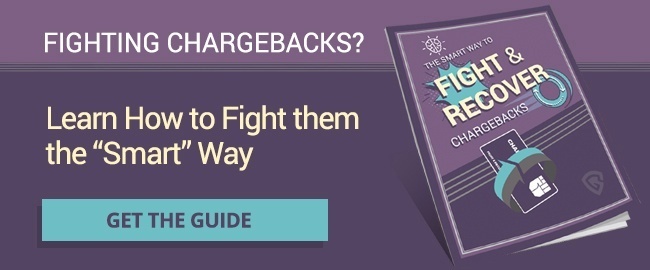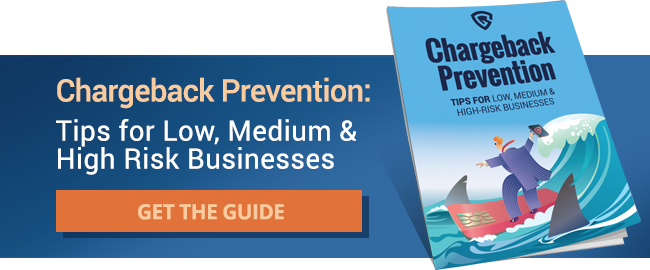How to Stop Chargebacks in Their Tracks
However "risky" your business is, chargeback prevention is of utmost importance. Aside from the loss of revenue—which can run more than double the amount of the original transaction being disputed—exceeding your chargeback threshold poses very real dangers for a merchant.
Some payment processors will move your account into a higher risk category, charging you more fees, or you could lose your merchant account entirely, forcing you to sign up with an expensive "high-risk" payment processor if you want to keep accepting credit cards.
How Low-Risk Businesses Stop Chargebacks
Merchants that sell their products in a card-present environment—where the customer physically hands you their card and you process it in front of them—make up the bulk of the lowest risk tier. Some online retailers that sell physical goods at a low volume may also be considered low-risk.
Low-risk doesn't mean chargebacks never happen, of course, and if you want to stay at that low-risk level, here are some chargeback prevention tips that might be relevant to your business:
- Use EMV/3-D Secure technology. Your point-of-sale system should include a chip reader to prevent fraudulent transactions. This isn't an option for online merchants, but 3-D Secure can provide some additional authentication security in that case.
- Provide excellent customer service. A secure transaction environment can prevent true fraud, but many "friendly fraud" chargebacks arise out of frustrations with poor or slow customer service. Be responsive, attentive, and readily available in order to reduce chargebacks due to customer dissatisfaction.
- Fix automation errors. Self-checkout systems and one-click shopping features can make it easy and convenient for customers to make purchases, but it's easy for them to make mistakes too. Streamlined systems should make it easy to catch and fix errors before the card is charged.
How Medium-Risk Businesses Stop Chargebacks
Most online retailers will fall under the medium-risk category, as well as card-present retailers who sell products for which a strong secondary market exists, like jewelers, high-end fashion shops, or ticket vendors.
Here's how medium-risk businesses can stop chargebacks:
- Use clear identifiers on credit card statements. This is an easy fix for an all-too-common problem. Sometimes the name of your store isn't the same as the name on your merchant account. When the customer sees that name on their credit card statement, they don't recognize the purchase, and they call their bank to ask for a chargeback. Make sure the name that appears on credit card statements won't confuse your customers.
- Expand the availability of your customer service. Your customers can contact their banks to get a chargeback rolling 24/7. Even if you can't provide live, around-the-clock customer service staffing, any improvements you can make to the quality and accessibility of your customer service will help reduce chargebacks.
- Set realistic expectations. Don't oversell your product or make claims that you can't really back up. Misleading your customers will lead to dissatisfaction and distrust, two feelings that often lead to chargebacks.
How High-Risk Businesses Stop Chargebacks
Businesses are considered high-risk when they carry high rates of fraud or losses. This often means a card-not-present transaction environment, and ephemeral products like online subscriptions with recurring billing. Some industries, like travel or gambling, are considered inherently high-risk.
You might also be classified as high-risk if you have a chargeback rate higher than 1%. Other individual factors may also come into play.
But even high-risk businesses have ways to stop chargebacks:
- Spell out your terms and conditions clearly. For subscription-based merchants, it's important to leave nothing unsaid or implied. Make sure your customers know exactly what they're agreeing to in terms of charges and billings.
- Verify purchases over the phone. A three-way phone call between you, your customer, and their issuing bank can show intent and shift fraud liability to the card issuer if a chargeback later arises. This might seem like a hassle, but it can be a great safeguard for high-dollar transactions.
- Use stronger fraud protection. If you're in an industry that's rife with credit card fraud, you have to use every tool at your disposal to weed it out.
- Be honest about your products. So many chargebacks could be prevented by merchants trying harder to manage customer expectations, rather than trying to boost sales with big, unrealistic promises. Be candid and truthful so that you don't lose your customers' trust.
Get Professional Help
Dealing with chargebacks might make you feel like you need therapy sometimes, but that's not the professional help we're talking about. Sometimes, effective chargeback prevention is just more than a small business can take on by themselves. That's when it makes sense to outsource those efforts to a chargeback management company.
A good chargeback management company will have the expertise to handle both prevention and representment and will have staff on hand at all times to issue immediate responses to chargeback notifications. Outsourcing can be costly, but for merchants who are about to cross their chargeback threshold, they can be well worth every dollar spent.
Want more guidance? Download our eGuide, Chargeback Prevention: Tips for Low-, Medium- and High-Risk Businesses today.





